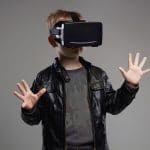
3-D (three-dimensional) movies may seem like a relatively modern phenomenon, however the first 3-D movie was actually created in 1922! But 3-D entertainment is now exploding across our cinema and television screens (and even laptop computers) transforming the viewing experience and creating a new wave of entertainment led by block buster movies such as Avatar.
However, not everyone can enjoy the 3-D experience. According to the Royal College of Ophthalmology, approximately 2-3 per cent of the general population cannot perceive 3-D images because of the early onset of squint, or an eye problem that develops later in life.
The principle behind 3-D imaging is that we have binocular vision, with two eyes separated by a space of 2-3 inches. This separation causes each eye to see the world from a slightly different perspective; when combined, this single image enables us to perceive depth and distance, and to see the world and media content in ‘3-D’. If there are multiple objects in our field of view, we can tell their relative distance. If you look at the world with one eye closed, you can still perceive distance, but your accuracy decreases and you have to rely on other visual cues.
The brain combines these two images from our eyes into one composite image. A simple way of testing this is to look at the same object with each eye covered alternately; the image shifts very slightly from eye to eye.
In a cinema, the reason we wear 3-D glasses is to feed different images into our eyes. The screen actually displays two images, and the glasses cause each image to enter a different eye. At many 3-D venues, the preferred method is to use polarized lenses because they allow color viewing. Two synchronized projectors project two views onto the screen, each with a different polarization. The glasses allow only one of the images into each eye because of the different polarization of the glasses.
In order to see in 3-D we must have good vision in both eyes and they must work together simultaneously. However, for people who have a vision misalignment or those who have severe eye conditions, viewing in 3-D is difficult – if not impossible. Some of the severe vision conditions which prevent us seeing in 3-D include ambloypia (lazy eye), strabismus (crossed eye), convergence insufficiency (unable to maintain the correct alignment of the eyes for near targets) and diplopia (double vision).
For those of us lucky enough to be able to enjoy the miracle of 3-D technology, there is still a concern that watching 3-D entertainment can cause side effects, with claims that these can include headaches, dizziness, nausea and eye strain. 3-D technology is a remarkable concept which has added depth and enjoyment to our viewing experience. Watching 3-D does not damage the eyesight; however, if any symptoms or side effects should appear and persist then it is recommended to visit an eye care professional.










